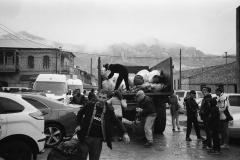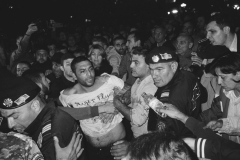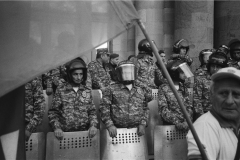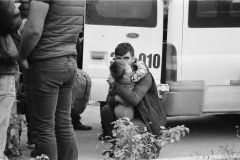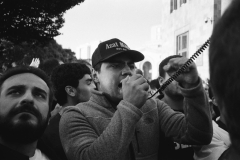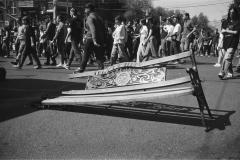by Ambra Visentin
In September 2023, Azerbaijan launched a large-scale military offensive against the self-declared breakaway State of Artsakh in the Nagorno-Karabakh region, which is internationally recognised as part of Azerbaijan but has been disputed with Armenia since 1993. The action has forced more than 100,000 Armenians living in the area to flee. The self-proclaimed republic of Nagorno-Karabakh was officially dissolved on 1 January 2024.
To discuss this epilogue to a long conflict and the current peace negotiations, we speak to Dr Nadja Douglas, a political scientist and researcher at the Centre for East European and International Studies (ZOiS) in Berlin.
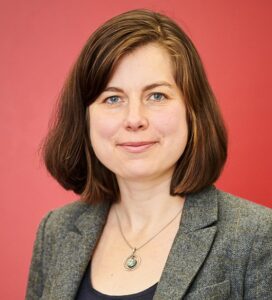
In your publication from September 2023, you argue that Nagorno-Karabakh has been ‘sacrificed’. Who allowed this sacrifice and why?
“In the aftermath of the events of 19-20 September, Nagorno-Karabakh has been sacrificed by several sides to varying degrees and for very different motives. The international community did not react with a common approach to Azerbaijan’s use of force in order to push for a final settlement between Azerbaijan and Armenia. The Russian Federation did not intervene, among others as a result of the war against Ukraine and the need to maintain good relations with Azerbaijan as partner for trade, transit and circumventing Western sanctions. Finally, Nagorno-Karabakh has been sacrificed by Armenia itself, due to the necessity to save its own territorial integrity. Armenia is in a very weak position vis-à-vis Azerbaijan because of the 2020 war and is apprehensive of further Azerbaijani assaults unless a peace agreement is achieved in the near future.”
With the Azerbaijani victory in the latest offensive, there has been renewed talk of the ‘Zangezur corridor’, the roughly 30-kilometre stretch of Armenian territory that separates Azerbaijan from its Nakhchivan exclave. What developments can we expect?
“It is very difficult to say at the moment. Azerbaijan has actually given up, perhaps for the sake of the peace agreement, on pushing for the so-called Zanzegur corridor. Nevertheless, Baku continues to demand an unimpeded transport route connecting Western Azerbaijan with the Nakhchivan Autonomous Region, arguing that Armenia committed to in the November 2020 trilateral peace agreement with Russia and Azerbaijan. Armenians fear that Azerbaijan could enforce a kind of exterritorial status of the corridor, de facto cutting off the southern region of Syunik from the rest of the Country. Currently, Azerbaijan is also looking for alternatives via Iran. They still have the idea of realising this one route, but I assume that they will not try to get it at any price.”
Where are we at in the peace process?
“Both sides are being quite pragmatic. Armenia wants this peace deal, mainly to secure its borders and to have a document that guarantees that Azerbaijan will not continue to make military incursions into Armenian territory, as has been the case for at least the last two years. However, the prospects for a peace deal are very difficult to assess because at the moment the sides can’t agree on whether it should be a mediated deal or whether it should be realised on a bilateral basis, which, as I said, would disadvantage Armenia.
It’s undeniable that both sides want it, it’s true, for different reasons and with different rationales behind it, but they have been at this point, very close to achieving an agreement, several times before in the history of the conflict. However, this is the most concrete and tangible peace process that we have witnessed, at least in the last decade. Yet, looking at it from a bigger picture, we are far from a sustainable positive peace. There is so much hatred, resentment and desire for retaliation between the two societies. Moreover, Azerbaijan’s rhetoric is still quite aggressive, which obviously obstructs a mutual understanding and dialogue between the two populations in the long run.”
What are Azerbaijan’s priorities?
“Azerbaijan has two main reasons for continuing peace negotiations with Armenia. First, they want to cement their victory in a document. They have successfully reclaimed Nagorno-Karabakh. It was a long-term goal and a sort of ‘reason of State’ to ‘bring Karabakh back home’. This gave legitimacy to the entire regime of President Ilham Aliyev. They want this peace agreement, but they don’t want Karabakh to be part of it, because they consider this conflict to be over anyway.
The second aspect is economic. Azerbaijan aims at reviving the regional connectivity. Together with Georgia, they are already thinking about the future, how a more reunited South Caucasus region could become a major transport and transit hub.”
What are Armenia’s prospects?
“Armenia wants borders demarcated and prisoners of war returned, but it is also interested in boostering connectivity, because it would benefit immensely from the opening of borders with its adversaries to the East and to the West. This would include the reopening of former railway lines and new road connections throughout the South Caucasus region. Another important issue is the protection of cultural heritage.
Recently, there have been calls to split the negotiations by separating peace talks from border demarcation. But this would probably not be to Armenia’s advantage.”
At the beginning of our conversation, you mentioned Russia’s export interests as a turning point. Can you give us an idea of how trade with the EU via Azerbaijan is growing?
“As it is well known, the EU Commission has concluded a gas deal with Azerbaijan in mid-2022 to double the amount of gas imports to the European Union from 2027. This was meant to compensate for Russia’s decision to cut its gas exports to Europe by 80% following Western sanctions in reaction the war in Ukraine. Facing the risk to be stuck with its own gas and sinking profits, Russia looked for other alternative markets. Exporting gas to third Countries like Azerbaijan, Turkey or India, who in turn re-export to the EU makes perfect sense for Russia. We know very well that Azerbaijan on its own would never be able to meet this quota without the use of Russian gas. It is essentially being laundered.”
What is the situation of refugees from Nagorno-Karabakh?
“Armenia is still a very poor Country and a very small one in terms of population. So it’s a huge burden for it to integrate more than 100,000 refugees. The Government’s support cannot go on indefinitely. Armenia does not have the same resources as Azerbaijan, which for example has been supporting some refugees from Karabakh and surrounding regions for over 30 years. Between 1992 and 1994, some 700,000 people had to flee the regions that were later annexed by Armenia. To this day, some of these people are being supported by the Azerbaijani Government, and some of them are living under very difficult conditions, which is also deplorable considering how prosperous a country Azerbaijan is.
The European Union, for its part, has already, at least for the moment*, allocated several million euros for emergency aid, especially to help the refugees. However, emergency aid is one thing, but supporting whole families over a long period of time, to find housing for them, integrate them into the job market and the education system is an immense challenge and long-term commitment.”
* In October 2023, the EU mobilised a further €500,000 on top of the €1.17 million in humanitarian aid it provided for the Nagorno-Karabakh crisis earlier that year. Since the major escalation of the conflict in 2020, the EU has supported humanitarian operations in Armenia and Azerbaijan with more than €21 million, ed.
Armenia: a forgotten war
Photo essay by Eugene Shalnov*
Photo 1: Goris, Armenia. Refugees from Artsakh, arriving in the back of a truck, unload their belongings. For several days, people left Artsakh using any available means. A multi-kilometer traffic jam of buses and trucks filled with people, vehicles with trailers attached to them, and military transport stretched from Stepanakert to Goris. The flow of refugees did not diminish day or night
Photo 2: Yerevan, Armenia. A clash between the police and protesters erupted due to the detention of one of them. According to various reports, during the protests, between 200 to 300 people were arrested
Photo 3: Yerevan, Armenia. The police have strengthened the cordon around the Government building at Republic Square. For four days, protesters attempted to break into the building. During the clashes, protesters used rocks, bottles, and anything they could find on the street to inflict as much damage as possible. On the first day of protests, the police had to use flash grenades. After that, the number of police officers at the protests increased several times
Photo 4: Goris, Armenia. A family of refugees stands in front of the registration center set up in the Dramatic Theater. Due to the impossibility of entering and leaving Artsakh, which was linked to the nine-month blockade, many families were only reunited after the start of the conflict and the withdrawal of Armenians from Artsakh
Photo 5: Yerevan, Armenia. Every street demonstration was accompanied by speeches from speakers. In different parts of the city, on the streets, one could hear completely different political slogans. However, all of them were directed against the current Government
Photo 6: Yerevan, Armenia. A column of protesters moves through the city, blocking the streets. For three days, people walked through the city and obstructed traffic using makeshift means. More often than not, the protesters would block a street for a few minutes and then move on, leaving benches and garbage bins on the road behind them. The next day after the roadblocks started, practically all benches and trash bins in the city center were gone
——————————————–
* Eugene Shalnov born in 1995 in St Petersburg, Russia, Eugene Shalnov graduated from art school in 2013 and served in the army before completing his training as a pastry chef in 2016. For the next two years, he worked in various jobs while travelling around Russia. From 2018 to 2022, he worked as a photographer and lighting designer at a theatre in St Petersburg, winning awards. In 2022, he graduated from the DOCDOC School of Contemporary Photography, completing a project on volunteer medical aid.




















